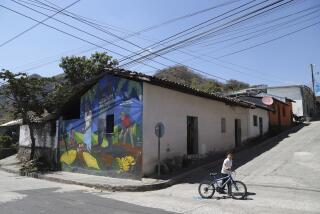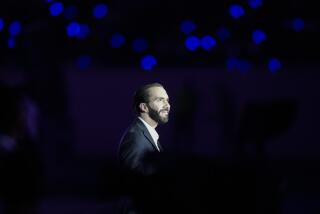Sandinista Front Deeply Divided : Nicaragua: A battle in which troops killed ex-comrades underscores growing split over the party’s direction.
MANAGUA, Nicaragua — Troops were bearing down on the positions taken by Honduran Pete and his band of rebels, all former Sandinista soldiers who occupied the northern city of Esteli to press their demands for land.
But Honduran Pete was not concerned, his wife recalled later.
“I warned him, get out of there!” Zoila Altamirano said. “He said, no, they won’t do anything to us. They are Sandinistas, just like us.”
And that was Honduran Pete’s mistake. The army, still controlled by Sandinistas, did attack their former comrades, leaving many dead. The 24-hour battle of Esteli last month has given army commander Gen. Humberto Ortega, arguably the most powerful Sandinista in Nicaragua, a desperately needed chance to show the world his willingness to use force--even against his own people--to impose law and order on this country.
It was a message intended as much for Washington as for local consumption.
But at what price? The actions of the army Ortega directs shocked many Sandinistas, deepening divisions within the Sandinista Front and alienating many rank-and-file party militants to whom the rebels’ demands seemed perfectly just.
“This tragedy,” Sandinista militant Silvio Prado wrote, “shows (the army) converted into an inflexible force . . . that mercilessly cuts down a social protest, more in the interest of keeping one man in command than in maintaining its status as a people’s (army).”
Prado’s harsh criticism, appearing in the Sandinista newspaper Barricada, echoed the opinions of many. Luis Carrion, a member of the National Directorate that still runs the party, described the loss of Sandinista lives at Sandinista hands as an “enormous trauma” for the Sandinista Front.
Ever since its embarrassing loss to Violeta Barrios de Chamorro in 1990 elections, and as its sponsors--the Soviet Union and Cuba--faded, the Sandinista Front has grappled with a divisive debate over the direction of the party.
Many members complain that the leadership, after a decade in power, is out of touch with its base. Some believe that the Sandinista Front is working too closely with Chamorro’s government, and they see Gen. Ortega as the most glaring example of that. Others argue that keeping a hand in the government and supporting state institutions is the best way to return to power.
A group of 29 leading party members, including legislators, mayors and labor unionists, published a six-point communique a couple of weeks ago demanding that the party return to its original goals and distance itself “clearly” from the government.
“The greatness of our party has been, and should continue to be, putting ourselves on the side of the people, and not on the side of power structures that repress the people,” said the group, which reflects the party’s left wing.
The debate now has reached such a crisis that Sandinista leaders have agreed to hold an extraordinary party congress, two years ahead of schedule. The forum will be used to thrash out some of these issues, and there will be a move to revamp the National Directorate.
In the wake of Esteli, the arguments in the party have escalated to the point that some Sandinistas now speak of an irreparable fissure. Historically, however, the Sandinista Front has been remarkably adept at subduing internal disputes in the interest of unity.
That was easier when they fought a common enemy--dictator Anastasio Somoza, ousted in a Sandinista-led revolution in 1979; or the U.S.-backed Contra rebels, who waged a war to topple the Sandinista government through the 1980s.
But the party has suffered discrediting blows. In the months after they lost the election but before leaving office, many ranking party activists helped themselves to homes and businesses in a scandal now referred to as the pinata . And the discovery last May of an illegal arms depot and leftist kidnaping ring that probably operated with Sandinista collusion has done more damage to the Sandinistas’ reputation.
“We haven’t done a single thing . . . to recover our ethical credibility,” said Carlos Tunnermann, who served as the Sandinista government’s ambassador to the United States and now represents a dissident wing of the party. “The fact that people are loyal to Sandinismo does not mean they are willing to accept the current leaders. The bases are more moral (than the leaders). They demand a more strict ethical conduct.”
For this and other reasons, the movement to change Sandinista leadership is gaining momentum. The party is run by the National Directorate, made up until recently of nine comandantes who won the revolution and a place in Nicaraguan history but who are coming under increasing criticism.
One of the nine died of cancer, and party Secretary General Daniel Ortega, the former president, replaced him with two longtime allies, rebuffing suggestions that a woman or other new blood might invigorate the directorate’s thinking. Pressure is mounting, however, and a growing number of key Sandinistas are calling for change.
The Esteli episode was surprising to many because no one expected the Sandinista army to attack--or Honduran Pete, a former army major whose real name is Victor Manuel Gallegos, to occupy the city so brazenly.
About 1,500 former soldiers and former Contras have taken up guns to demand that the government make good on its promises of land and credits, and until now Chamorro usually negotiated with them and offered amnesty.
Chamorro last week reiterated an ultimatum to the armed groups, demanding that they enter security zones by the week’s end and disarm by Aug. 31 or face attack.
One of Gen. Ortega’s motives in sending his troops into action against the rebels, analysts and diplomats said, was to bolster the impression that he was following orders of a civilian president--at a time when Chamorro’s ability to control the Sandinistas is under question.
Ortega’s attitude seemed to contradict that of his brother, Daniel, who used a July 19 rally celebrating the anniversary of the defeat of Somoza to encourage “popular mobilization” against the government.
On the surface, there appears to be a parting of ways between the brothers Ortega. At a meeting earlier this year with Honduran colonels, for example, Humberto Ortega openly criticized his brother as a demagogue, sources said. But, veteran analysts caution, some of this apparent split may be more for show as each maneuvers to carve out his position of power.
More to Read
Sign up for Essential California
The most important California stories and recommendations in your inbox every morning.
You may occasionally receive promotional content from the Los Angeles Times.











